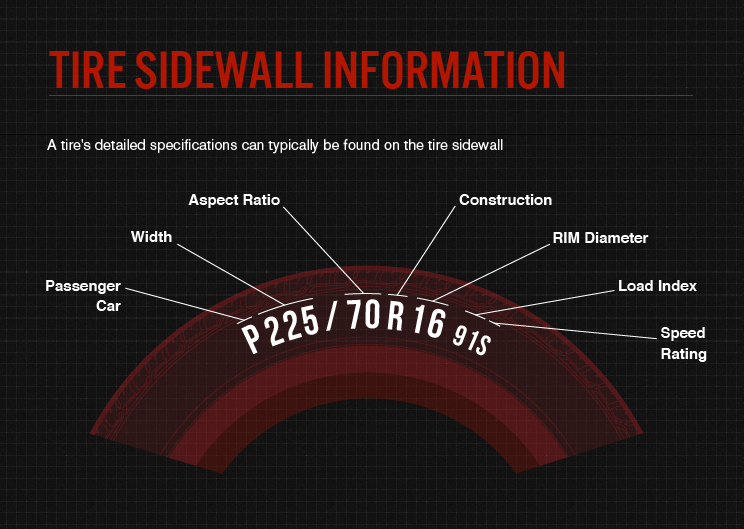How do I find out what size my wheel or wheel cover is?
Posted by Rick Dynek on 22nd Mar 2023
One of the most common questions and those asking should not be embarrassed is "How do I figure out what size my hubcap or wheel is?"
While many attempt to measure or even page through their vehicle owners manual the simple technique to figure this out is to simply look at the tire. Despite what you may believe or was told the tire will always tell you the size of your tire and that is always a direct reflection of both your wheel and or the hubcaps / wheel covers.
When looking at your tire you will find a letter and number combination usually starting with either P or LT depending on the size of the vehicle. Following that number will tell you the other dimensions of the tire followed by R and then a pair of numbers.
For Example: P225 / 70 R 16 would mean that your Tire Size for Wheel, Wheel Cover, or Hubcap purposes is 16" because of the R16 that tails the information on tire.

For those more interested in the details of all the numbers on a tire and what they mean here is your info
The Letters “P” and “LT”
For most vehicles, you’ll see the letter “P” before the number sequence begins: P225/70R16 91S. The “P” is short for “P-metric” which is a designation by the Tire and Rim Association for a “passenger car” tire type. This signifies the tire was designed to primarily be used on passenger vehicles, which can include cars, minivans, SUV’s, and other light duty pickup trucks. If you see “LT” instead of “P,” it’s because you need “light truck” tires – “LT” is short for “LT-metric” which is a designation by the Tire and Rim Association for a “light truck” type tire. Light truck tires are designed to be used on vehicles capable of carrying heavy cargo or pulling trailers.
Similarly, “T” stands for “temporary” and is for your spare tire. If you see “ST,” that means “special trailer.”
Width
The first number to appear in your tire size information is the width, in millimeters, of the correct tires for your vehicle: P225/70R16 91S.
Tire width always refers to the measurement from one sidewall to another. Thus, a tire with the measurement “P225” is for a passenger vehicle and has a nominal width of 225 millimeters.
Aspect Ratio
After the slash mark, the next number you see is for the tire’s aspect ratio, which essentially tells you how tall your tire’s profile is: P225/70R16 91S. Aspect ratios are delivered in percentages. Tire makers calculate the aspect ratio by dividing a tire’s height off the rim by its width. If a tire has an aspect ratio of 70, it means the tire’s height is 70% of its width.
Lower aspect ratio tires, such as a 60 series, generally offer vehicle handling performance advantages over higher aspect ratio tires, such as a 75 series.
Construction
After the aspect ratio comes a letter that indicates the type of internal construction maintaining your tire’s stability: P225/70R16 91S.
There are two types of construction that you may see on the sidewall of a tire:
- R – Radial
- D – Diagonal or Bias Ply
Radial tires represent the vast majority of tires on the road in the United States today; thus “R” will usually be shown in the tire size designation. Radial construction means the tire’s internal ply cords are oriented in a radial direction, from one bead over to the other, essentially perpendicular to the axis of rotation.
Rim Diameter
The next number is the diameter code, in inches, of the rim onto which the tire can be mounted. For example, a tire with the P225/70R16 91S would fit a rim with a 16-inch diameter.
Load Index
The next figure in the sequence is your tire’s load index, which tells us how much weight, in pounds, the tire can support when fully inflated: P225/70R16 91S
We call it the load “index” because the number doesn’t tell us the precise number of pounds the tire can carry, at least not by itself. However, the number does correspond to a specific load capacity listed in an index. Beginning with 1 and ending with 150, numbers in the load index represent carrying capacities of 99 to 7385 lbs.
Speed Rating
The final figure in a tire size sequence is the speed rating, which is indicated by a letter: P225/70R16 91S. Just as your load index number corresponds to a particular load, your speed rating letter corresponds to a particular speed capability based on a standardized laboratory test.
For example, a tire with speed rating “S” is rated for up to 112 mph, while a tire rated “R” is up to 106 mph. Remember that this isn’t a recommended cruising speed. Of course, you should always follow legal speed limits on roadways.
Tires with higher the speed ratings, tend to offer increasing handling performance. Replacement tires must have the same or higher speed rating to maintain vehicle speed capability. If a vehicle has tires with different speed ratings, it is the speed rating of the “slowest” tire that dictates the vehicle top speed.









































